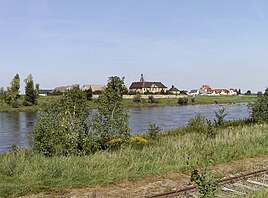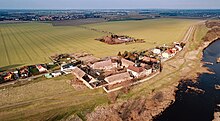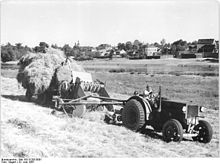Promnitz (Zeithain)
|
Promnitz
Zeithain parish
Coordinates: 51 ° 18 ′ 38 " N , 13 ° 18 ′ 33" E
|
||
|---|---|---|
| Area : | 1.61 km² | |
| Residents : | 43 (December 31, 2014) | |
| Population density : | 27 inhabitants / km² | |
| Incorporation : | 1970 | |
| Incorporated into: | Röderau | |
| Postal code : | 01619 | |
| Area code : | 03525 | |
|
Location of Promnitz in Saxony |
||
|
Promnitz, view from Riesa
|
||
Promnitz is a right side of the Elbe situated district of the Saxon community Zeithain in the district of Meissen . The place was first mentioned in 1185 as a prominent figure .
geography
The place is located directly on the Elbe between the towns of Moritz and Bobersen on the Elbe Cycle Path . Around 1900 the place was described as a manor settlement with a row of houses and was surrounded by a manor block corridor. Opposite Promnitz, the Jahna flows into the Elbe, which is a disadvantage during floods. The place lies in an old alluvial cone of the Elbe on a flood island. Federal highway 169 , which can be reached via a side road, runs north of Promnitz . Promnitz is connected to Riesa via this road ; the city is across from Promnitz on the other side of the Elbe and can also be reached by passenger ferry.
history
The name of the place indicates a ferry place and is derived from the Old Sorbian word Prom, which means ferry. The place name was changed several times, so Promnitz was called Prominiz in 1186 , 1234 Promniz , 1272 Promeniz , 1474 Promnicz , 1519 forberg Kleinpromnitz , 1540 Groß Bromsdorff , 1551 Vberbromnitz and Groß- and Ober- or Klein-Promnitz in 1696. First in 1791 the current spelling of the place name had prevailed.
Promnitz was originally owned by the Riesa monastery as a fishing village in 1185 . The ferry is mentioned for the first time in 1197. In 1272 a manor is mentioned, which was probably in the area of the castle and belonged to Hermannus de Promeniz . Around 1324 there was a tabern in the village, there were two outbuildings , one of which belonged to the Riesa monastery and the other to a feudal lord from the noble family of Promnitz . The place is divided into Groß- or Oberpromnitz and Klein- or Niederpromnitz. From 1432 to 1699 Niederpromnitz belongs to the von Köckeritz family . The place originally parish to Riesa belonged to the Röderau church from 1555 . In 1594 there were 4 houses in Groß-Promnitz and 5 houses and vineyards in Klein-Promnitz. In the middle of the 16th century, both Vorwerke were manors and in 1626 finally came into one hand. In 1625, a flood destroyed the small Werder, which still existed in the old river bed to the extent of half an acre of agricultural land. Today's three-wing castle was built in 1604 over an older building.
The plague also raged in Promnitz. In 1632 117 people died of the plague in the Zeithain parish, in 1633 24 people died of this disease in Promnitz alone.
In 1651 Promnitz suffered from floods. In 1667 there was a ship mill in Promnitz , which still existed as a catchy ship mill in 1773. From 1696 Promnitz belonged to the office of Großenhain . From 1717 the von Wolfersdorff family is the owner of Promnitz. In 1728 the middle wing of the palace was rebuilt in the Baroque style by Friedrich Albrecht von Wolfersdorff .
From May 20th to June 29th 1730 the pleasure camp of Zeithain took place near Streumen . Grandstands were erected between Moritz and Promnitz so that the spectators could comfortably watch the parade of ships and the big fireworks. August the Strong himself, standing at a window of the ballroom of the Promnitz Castle, enjoyed the mighty five-hour fireworks on the Elbe on June 24th. Several months earlier, 200 carpenters had started to use 18,000 logs and the same number of boards to build an "80 cubits high and 200 cubits wide" scaffolding on the Riesa side of the river, opposite the specially converted Promnitz Castle, which was covered with 6000 cubits of canvas and painted. to represent a fairy palace. The illumination was done by 400 carpenters. In addition to the fairy palace, there were among other things 60 cannons for firing, 48 mortars for throwing flares, 80 rocket boxes and 24 large fire wheels. At the same time a fleet, illuminated to the top of the mast, led by fire-breathing whales and dolphins, sailed past the high-ranking guests gathered in pavilions, whose glory and glory were praised by the royal chapel on the main nave.
On the same occasion, the Prussian Crown Prince Friedrich , who had got into a violent dispute with his father, the soldier king Friedrich Wilhelm I , during the maneuvers, revealed to his friend Hans Hermann von Katte at Promnitz Castle the plan to flee to France in order to avail himself of the powers of education to withdraw from his strict father. Katte tried to prevent him from doing so, but finally supported the unsuccessful attempt to escape from the travel quarters in Steinsfurt in early August and was executed in front of Friedrich in November 1730.
The von Thielau family owned the place from 1746 to 1832. In 1808 Promnitz consisted of a tavern, five hereditary houses, one hereditary house with a garden and a house with a garden. During the Wars of Liberation , on September 29, 1813, the avant-garde of the Prussian von Blücherschen Corps under Gebhard Leberecht von Blücher camped between Zeithain and Röderau and the surrounding towns were looted. In March 1830, the dam near Promnitz broke due to heavy ice and a house was completely torn away. The Elbe dam at that time did not yet have the appearance it does today, there was only a smaller protective dam, which the Promnitz owner of Thielau had built in 1821. Sometimes the place was completely surrounded by water, even during minor floods, and cut off from the outside world for weeks. The construction of the railway bridge at Riesa made the problem even worse, as the ice built up on the bridge piers in winter.
Around 1840 Promnitz consisted of nine houses and the castle. The inhabitants lived mostly from shipping. Two residents were allowed to operate a boat ferry, and a tailor, a butcher and a bricklayer lived in the village. In 1855 the Elbe dam broke again near Promnitz due to heavy ice on the Elbe. Between 1856 and 1875 Promnitz belonged to the Riesa court office , then to the major grove . In 1862 the Elbe dam broke again, this time on a large scale. After this dam break, the current Elbe dam was built between Moritz and the state border, which protects the villages much better. In 1925, 163 residents of Promnitz were Evangelical Lutheran , 4 residents were Catholic and 2 residents belonged to other denominations.
In the particularly severe winter of 1928/1929, the Elbe froze over completely. The Promnitz ferryman laid out a marked out footpath that could be used to cross the Elbe on foot from February 12, 1929 to mid-March.
In 1938 Promnitz was incorporated into Röderau. Saxons came after the Second World War in the Soviet zone of occupation and later the GDR. The rural life in the place was based on the principle of agriculture in the GDR . After the expropriation of the Dresden banking family Rudolph, who had owned the estate since 1873, the 161 hectares of manor land were divided among 14 new farmers in 1945 . The territorial reform in 1952 assigned Promnitz to the Riesa district in the Dresden district . In the 1950s, the farmers from Promnitz joined forces in the LPG Elbflur Röderau-Promnitz, which later became part of the LPG unit Röderau. The castle was divided into apartments and the outbuildings were used by the LPG. After German reunification , Promnitz came to the re-established Free State of Saxony. The following regional reforms in Saxony assigned the place to the Riesa-Großenhain district in 1996 and to the Meißen district in 2008 . In 1996 the Treuhand sold the castle to an "investor" who, however, let it fall into disrepair.
In recent history, Promnitz was badly hit by the flood of the century in 2002 . On August 16, 2002, the Elbe dam broke between Moritz and Promnitz and caused great damage in Promnitz and the surrounding villages. In a short time the lowland between Röderau, Promnitz and Moritz was full. The castle was also affected and has been empty since then. The rest of the dam was flooded because it was lower than the water level. 14 of 16 properties were classified as uninhabitable after the flood. With great effort the Promnitzer restored their houses.
In 2013 Promnitz was hit by the floods again, the dam was flooded again and broke on June 6, 2013. Once again, major damage had to be repaired for the residents. In 2013 a cultural and castle association Promnitz was founded , which began with the structural emergency security of the decaying castle; In 2017, the von Wolffersdorff family, involved in this, was able to buy back the castle.
Population development
The population has increased steadily since the Middle Ages and had reached its maximum in 1925. Since then, the population has been falling again. In 2013, around 35 people lived in the village. Because of the last two floods, a large part of the population has left the place.
| year | Residents |
|---|---|
| 1551 | 8 residents |
| 1764 | 17 cottagers |
| 1834 | 110 |
| 1871 | 140 |
| 1890 | 167 |
| 1910 | 155 |
| 1925 | 169 → Röderau |
literature
- Saxony's church gallery. 7th volume. The Grossenhain, Radeberg and Bischofswerda inspections . Dresden 1841. Page 56 ( online ), accessed on January 18, 2014
- About Oschatz and Riesa (= values of our homeland . Volume 30). 1st edition. Akademie Verlag, Berlin 1977, p. 84.
- Cornelius Gurlitt : Promnitz. In: Descriptive representation of the older architectural and art monuments of the Kingdom of Saxony. 37. Issue: Amtshauptmannschaft Grossenhain (Land) . CC Meinhold, Dresden 1914, p. 241.
Web links
- Promnitz (Zeithain) in the Digital Historical Directory of Saxony
- Promnitz on the website of the municipality of Zeithain, accessed on January 22, 2014
Individual evidence
- ↑ a b Johannes Thomas: Three centuries of life in the old Patrochy Zeithain 1567–1862 . In: Our home Riesa. Leaves for the care of the homeland love of local research and homeland security . tape 3 , 1930, p. 8-9 . , Riesa.
- ↑ Johannes Thomas: The cold of winter 1928/29 and its effect on life in our Riesa homeland . In: Our home Riesa. Leaves for the care of the homeland love of local research and homeland security . tape 2 , 1929, p. 13 . , Riesa.
- ↑ Johannes Thomas: On the prehistory of the dam construction between Moritz and the Riesa Elbe bridge . In: Our home Riesa. Leaves for the care of the homeland love of local research and homeland security . tape 2 , 1929, p. 12 . , Riesa.
- ↑ Photo Schröder, Merzdorf & Partner, Heike Berthold: Land Unter - Pictures of the flood of the century in 2002 around Riesa . 1st edition. Polyprint Riesa GmbH, Riesa 2003, p. 50 .
- ↑ Monthly report of the Saxon State Office for Environment, Agriculture and Geology, June 2013 (PDF; 4.5 MB) ( Memento of the original from November 10, 2013 in the Internet Archive ) Info: The archive link has been inserted automatically and has not yet been checked. Please check the original and archive link according to the instructions and then remove this notice.
- ^ Antje Steglich: New dyke and streets for a ghost village , in: Sächsische Zeitung , Riesa edition of October 15, 2013, accessed on January 22, 2014.
- ↑ Promnitz (Zeithain) in the digital historical directory of Saxony
- ^ Michael Rademacher: German administrative history from the unification of the empire in 1871 to the reunification in 1990. Grossenhain district. (Online material for the dissertation, Osnabrück 2006).
- ↑ With the incorporation of Promnitz into Röderau in 1938, only official population figures were collected for the entire community.





